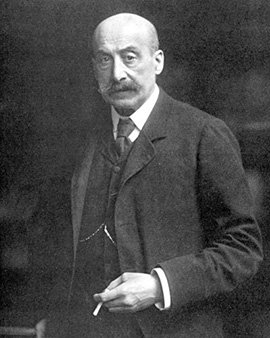Max Martin Liebermann was born at a time when Impressionism was firmly established in France. Political tensions prevented the exchange of art scenes and when open-air painting reached German artists, the art movement in France was already coming to an end. Max Liebermann went through a classical education and gained experience abroad. The young artist found inspiration especially among Dutch painters and devoted himself to the simple motifs of country life. Liebermann appropriated a naturalistic style of depiction, which shows the artist's great talent. Excursions into Impressionism cannot approach the works of Monet or Degas. Liebermann's palette is too strongly oriented towards the grey and brown tones of the Dutch artists. In the end, he lacks the light of the south, the lightness of the carefree summer days, which Berlin does not generously provide.
Liebermann's painting style is loosening. He finds a paradise at Wannsee and discovers his love for light-flooded leaves. Again and again the painter captures the pleasurable life in Berlin. In addition to portraying his wife Martha, his favourite motifs are the carefree enjoyment of the Havel and the splendour of the flowers in his own garden. Although the German Impressionists lacked the light of the French pioneers, the German Impressionists were able to take up the motifs. And since France was not an optional destination for political reasons, Liebermann sought recreation on the white beaches of his beloved Netherlands. The artist's palette brightens as he captures the pleasures of life. The colours become brighter, the painting style more vibrant and his pictures speak the language of the subjective artist's feeling.
Max Liebermann treads the path to modern painting. Liebermann develops into a recognised and sought-after artist. His personality makes him a socially and politically accepted artist of the Weimar Republic. Liebermann lived for art and found relaxation in his villa at Wannsee. In his garden idyll, he found distance from the already lively big city life in Berlin. At the same time, Liebermann found exchange with fellow artists here. With Hugo Vogel in particular, he shared his love of the garden and the special light at Wannsee. Both artists lived a stone's throw away from each other and made an impressive mark on the history of the lake. In Berlin, Liebermann's main place of residence was Pariser Platz. His father had bought the house with the number seven and Max lived here with his wife and daughters. Max Liebermann was an actor who lived for and served art. With the darkest chapter in German history, Liebermann was deprived of the foundation of his life. His Jewish roots and the modern form of his depictions led to a ban on exhibitions of his works. Liebermann withdrew. He lost his life's work at the age of 86 and died two years later in his house at Pariser Platz.
×





.jpg)
.jpg)
.jpg)
.jpg)
.jpg)
.jpg)
.jpg)
.jpg)
.jpg)
.jpg)
.jpg)
.jpg)
.jpg)
.jpg)
.jpg)
.jpg)
.jpg)
.jpg)
.jpg)
.jpg)
.jpg)
.jpg)
.jpg)
.jpg)
.jpg)
.jpg)
.jpg)
.jpg)
.jpg)
.jpg)
.jpg)
.jpg)
.jpg)
.jpg)
.jpg)
.jpg)
.jpg)
.jpg)
.jpg)
.jpg)
.jpg)
.jpg)
.jpg)
.jpg)
.jpg)
.jpg)
.jpg)
.jpg)
.jpg)
.jpg)
.jpg)
.jpg)
.jpg)
.jpg)
.jpg)
.jpg)
.jpg)
.jpg)
.jpg)
.jpg)
.jpg)
.jpg)
.jpg)
.jpg)
.jpg)
.jpg)
.jpg)
.jpg)
.jpg)
.jpg)
 - (MeisterDrucke-680875).jpg)
 - (MeisterDrucke-680875).jpg)
.jpg)
.jpg)
.jpg)
.jpg)
.jpg)
.jpg)
.jpg)
.jpg)
.jpg)
.jpg)
.jpg)
.jpg)
.jpg)
.jpg)
 - (MeisterDrucke-195304).jpg)
 - (MeisterDrucke-195304).jpg)
.jpg)
.jpg)
.jpg)
.jpg)
.jpg)
.jpg)
.jpg)
.jpg)
.jpg)
.jpg)
.jpg)
.jpg)
.jpg)
.jpg)
.jpg)
.jpg)
.jpg)
.jpg)
.jpg)
.jpg)
.jpg)
.jpg)
_-_(MeisterDrucke-162042).jpg)
_-_(MeisterDrucke-162042).jpg)
.jpg)
.jpg)
.jpg)
.jpg)
.jpg)
.jpg)
.jpg)
.jpg)
.jpg)
.jpg)
.jpg)
.jpg)
 - (MeisterDrucke-194337).jpg)
 - (MeisterDrucke-194337).jpg)
.jpg)
.jpg)
.jpg)
.jpg)
.jpg)
.jpg)
.jpg)
.jpg)
.jpg)
.jpg)
.jpg)
.jpg)
.jpg)
.jpg)
.jpg)
.jpg)
.jpg)
.jpg)
.jpg)
.jpg)
.jpg)
.jpg)
.jpg)
.jpg)
.jpg)
.jpg)
.jpg)
.jpg)
.jpg)
.jpg)
.jpg)
.jpg)
.jpg)
.jpg)
.jpg)
.jpg)
.jpg)
.jpg)
.jpg)
.jpg)
 - (MeisterDrucke-286443).jpg)
 - (MeisterDrucke-286443).jpg)
.jpg)
.jpg)
.jpg)
.jpg)
.jpg)
.jpg)
.jpg)
.jpg)
.jpg)
.jpg)
.jpg)
.jpg)
.jpg)
.jpg)
.jpg)
.jpg)
.jpg)
.jpg)
.jpg)
.jpg)
.jpg)
.jpg)
.jpg)
.jpg)
.jpg)
.jpg)
.jpg)
.jpg)
.jpg)
.jpg)
.jpg)
.jpg)






